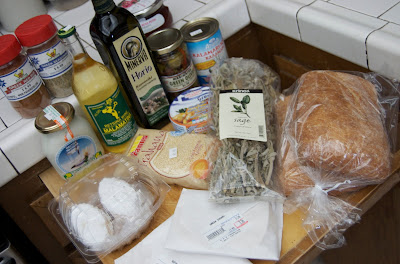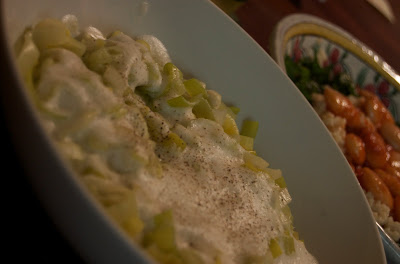If you’ve never been to Serbia, do you actually know where it is–unless you’re one of those oddballs like me who has a map fetish? Even I had to double check and see exactly where it fits in with the other Balkan States. It’s part of the former Yugoslavia, one of those countries that we vaguely know is over there somewhere east of Italy. Or is that Slovenia? Or Croatia? Or the generously syllabled Bosnia-Herzegovina?
As difficult as it is for someone who’s never been to Serbia to tell you just where it is, it’s equally difficult to pin down exactly what makes Serbian food Serbian. So I asked my pal Tanja to join me for dinner. As a first generation American from Serbia, she’s the truth meter I usually lack on these expeditions.
I just had to include this photo of Tanja holding a pic of her dad, a bodybuilder who was the first Mr. Yugoslavia in 1968. How cool is that?!
She suggested we go to Metro Cafe in Culver City. When I raised my eyebrows at the name and said it didn’t sound terribly authentic, she assured me it had the goods. Then she rather sheepishly explained that Serbian food is more or less a pastiche of the cuisines of the neighboring countries, so there’s a lot of Italian, Greek, Turkish and Hungarian on the menu. I assured her that that’s fine, because food borders and political borders have little in common. Cuisine is geographically, climatically and culturally determined–no respecter of lines dictated by governments and drafted by mapmakers.

We did start off with a Serbian treat, because the first thing to hit our table was ajvar, known as “Serbian caviar.” A spread of roasted red bell pepper, egg plant and chili peppers, it was richly textured, full flavored and mildly hot. Take a look at the spellings of these cousin words: ajvar and caviar. And neighboring Turkey’s word for caviar is “havyar.” See the etymological similarity? I imagine you could step into a kitchen next door and ask for one of these, and they’d know just what you were talking about. Well, that’s enough of a foray into linguistic geekdom for one blog entry, but thanks for indulging me!
Next was a basic Greek salad. At least you didn’t see it in my last blog entry! This lightly dressed pile of tomatoes, lettuce, onions, cucumbers and feta was a nice fresh intermission in between the rich flavors of the other dishes.
In spite of being completely landlocked, Serbia still manages to get its share of fresh seafood. These steamed mussels were dressed in a light sauce of tomato, garlic and parsley that made a nice soup for mopping up with that piece of charred bread on top.
My favorite dish was the pasulj, Serbian white bean soup. What made it a hit with me was that I detected the presence of smoked pork in it. You just can’t go wrong with that. It was basic but hearty and nourishing, mildly seasoned, except for the garnish of cracked pepper. The door was propped open, with the ocean breezes whisking in, so even though it’s August, there was a crispness to the air that made this soup even more welcome. Our server noted that the recipe comes from the chef’s mum. Okay, in unison everybody say, “Awwww!!!”
The menu contains plenty of meat–they certainly don’t shy away from it in veggie-happy LA. Our mutual friend, Vanessa, who is also of Serbian extraction, says the Serb table is all about meat, meat and more meat, “with the odd stew thrown in for digestive purposes.” Well that’s okay by me!
Chevapchichi is considered one of the national dishes of Serbia. These are beef sausages, but traditionally they were made of a combination of beef, pork and lamb. Still, these were really good, with a nice bit of char bestowed by the grill. They were served on a bed of sweet onions with some ajvar–which is an accompaniment as well as an appetizer–and fried potatoes that somehow managed to be more grease than potato. I don’t mean this in a bad way. They were incredibly good!
Tanja shared a recipe for pasulj, the Serbian bean pot we’d had, from one of her family cookbooks. The funky measurements in it make me think it was converted from metrics to avoirdupois, which is what we use here in the U.S. (who uses .35 ounces of anything?) Between the odd measurements and some ingredients being listed with no measurements at all, I decided to do a little searching. I think I’ve managed to cobble together a recipe that is to the spirit of the original.
Homemade pasulj: I’ll pick out the bay leaves and parsley stems before serving.
Serbian Bean Pot
(“Pasulj”)
Yields about 4 servings
Based on a recipe from Yugoslav Cookbook by Olga Novak Markovič (Cankarjeva založba, Ljubljana, 1986)
12 oz. white beans
Approximately 3 pints water
1 medium onion, finely chopped
1 medium carrot, finely chopped
parsley root (if you can’t find this, use a few parsley stems and chop the leaves for garnish)
2 cloves of garlic, minced
12 oz. smoked pork, cut into small bits if you use bacon
2 bay leaves
2 tablespoons tomato sauce
1 chili pepper (I used a Serrano), seeded, deveined and minced
salt and black pepper, to taste
Wash the beans well and soak overnight.
The next day, strain off the soaking water and add fresh cold water. Add to the bean pot all ingredients except salt and pepper, and simmer until beans and meat are tender.
***Remove the meat (if it’s a whole piece) and add a roux, made of 2 oz. fat (measured by volume) and 2 oz. flour (measured by weight). Simmer everything until thickened.
Season with salt and pepper when cooking is finished.
If you keep the pork whole, slice pieces of it and place one in each bowl and then ladle soup over it and garnish with chopped parsley.
***Now, about that roux: Some people panic as soon as they read a recipe and see they’ll have to make a roux or even a liaison. So we’re going to cheat. I’ll teach you a little trick so you can get around it. Mind you, it will taste much better if you actually take the time and effort to make a roux, because the flavor and texture will both improve the final product. (And you have to promise me that someday you’ll learn to make a proper roux, alrighty?) But for now, this is what we’ll do: cook half of the beans in a separate pot and purée them before adding them to the main pot about a half hour before cooking is finished. The result will be a nice rich, thick potage.
Dessert is problematic. The Serbian dessert menu includes sweets that are emblematic of other countries: Greece’s baklava; Hungary’s dobos torte and Turkey’s Turkish delight or ratluk, as they call it in Serbia.
Serbia has rice pudding too, but here they call it sutlijaš. And they top it with cinnamon and molasses, so I figured, why not? In the interest of portion control and not being a total glutton, I spooned the finished product into individual ramekins rather than one large bowl. And I stirred in the cinnamon while the rice cooked, so it would be well distributed. Himself and I test tasted two servings, one with molasses drizzled over it and the other with syrup. Hands down, the molasses was the winner in our household. But honey would be good, and I’m sure something rich like chestnut honey would be even better.
So, Serbian cuisine? As Tanja noted, when your homeland has been occupied by the Ottomans for a few hundred years and when it lies amongst an assortment of other countries with their varied cultures, it’s easy to just absorb what’s close at hand. But what Serbia has absorbed is, quite smartly, the good stuff. So if you find yourself wandering past a Serbian restaurant, stop in and have a bite. It will be good.























